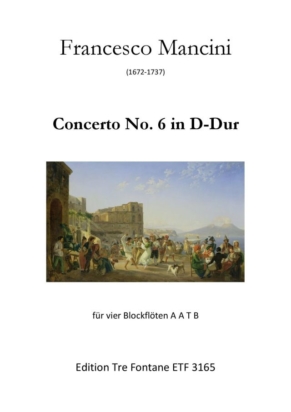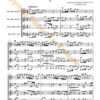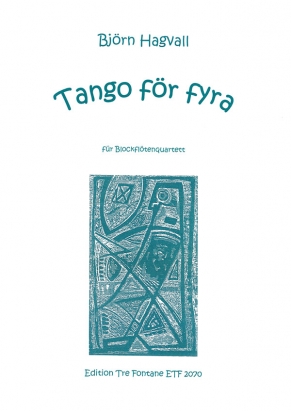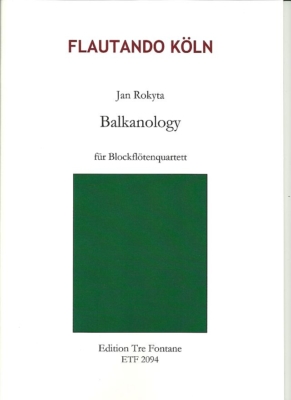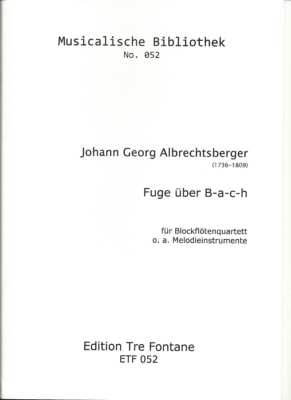Beschreibung
Francesco Mancini (January 16, 1672 – September 22, 1737) was one of the most influential Neapolitan composers of the Baroque period. He was not only known as a prolific opera composer (who composed at least 29 operas and 200 cantatas), but also as an excellent organ player, who was appointed as first organist and maestro of the Capella Reale. Alongside Allessandro Scarlatti, he undoubtedly played a key role in establishing the late Baroque Neapolitan musical style. As a director of the Conservatorio di S Maria di Loreto, he influenced many young musicians. Although Mancini dedicated his life to opera, his instrumental compositions are not second best, showing his great knowledge of counterpoint. His recorder sonatas and concertos make an important contribution to the Italian late Baroque recorder repertoire, which is widely performed around the world still nowadays.
The concerto No. 6 in D-minor is part of a collection called Manoscritto di Napoli 1725, which contains a total of 24 compositions. In addition to the 11 concertos by Mancini, we can find works by other well-known Italian masters, such as Roberto Valentino, Francesco Barbella, Allessandro Scarlatti, Domenico Sarri and Giovanni Battista Mele. The manuscript is entitled “Concerti di Flauto, Violino, Violetta e Basso di Diversi Autori”, although the individual pieces are called sonatas. Rather than the standard 18th century concerto, which typically consists of three movements, these works present four-five movements each, following the Corellian sonata de chiesa’s structure. This collection includes five separate part books, for recorder, violin I, violin II, viola, cello and basso continuo. Only three out of twenty-four concertos contain viola parts, namely concerto no. 10, no. 11 and no. 14.
The sonata sesta was originally written without any key signature in a Dorian mode: B flats (which suggest the tonality of d-minor) are marked across the score in a rather imprecise fashion, leaving a certain freedom to the interpretation. This arrangement for a recorder quartet highlights the great technical possibilities of such an instrument: melancholic melodies and virtuoso passages are shared by all voices, after careful consideration, and remain close to the original composition.
The first movement Amoroso presents a palette of theatrical effects, including the alteration of strong dotted rhythms, various tender melodies, false cadences, a general pause, alteration of minor and major tonalities, and dissonances. The imitations between different voices give soloistic moments not only to the first part but to the second and the third one as well.
The second movement Allegro is a well-structured fugue. The first 13 bars introduce the thematic melody in D minor, played by the second voice. An imitation in the dominant follows the main theme, initially played by the third recorder and then relaunched by the fourth one in the original D minor key. Eventually the first voice will respond in a dominant imitation as well. This section ends with a cadence in F major, and with elision the first voice begins the theme again. Between bars 13-20, Mancini transposes almost identically the beginning of the movement to F major: instead of the second recorder, it is now the first voice to start the theme and the second voice imitates it first, followed by an additional third voice between bars 13-16. This movement is filled with musical effects such as octave jumps, sequences, dissonant motives, sixteen notes passages which emerge through all voices and a general pause.
The following movement is an expressive Largo that begins with an idyllic F-major theme, which soon moves to darker minor keys: the ascendent long melody turns to shorter descending melodic fragments, taking us to a final chord on the D-minor dominant.
The last movement is an Allegro with theatrical elements such as repetitions, imitations, sequences and a small coda at the end. It begins with a four-bar theme, and the second bar is already interrupted after a beat with a general pause. In the original score, the second and third violins share the same unisono part for almost the entire movement. In this adaptation, an additional voice has been added to enrich the harmony.
This arrangement is dedicated to the Delle Donne Consort recorder quartet. Special thanks to Bart Coen for the unwavering support. Kinga Ludvai. 2022

